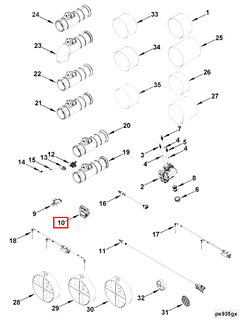This truck part is made by Cummins®. We guarantee that all of our parts are from the OEM (original equipment manufacturer), ensuring a proper fit and quality manufacturing.
We honor the warranty provided by the original equipment manufacturer.
The Cummins 4306985 Electronic Interface Module (EIM) is designed to enhance the operation of commercial trucks by facilitating communication between various electronic systems within the vehicle. This module ensures that the truck operates efficiently and reliably.
Basic Concepts of Electronic Interface Modules
An Electronic Interface Module (EIM) allows different electronic systems within a vehicle to communicate with each other. It acts as a mediator, ensuring that data and commands are accurately transmitted between components such as the engine control module, transmission control module, and other subsystems. The EIM integrates these systems to maintain the overall functionality and performance of the vehicle 1.
Purpose and Role in Truck Operation
The Cummins 4306985 EIM is designed to enhance truck operation by facilitating communication between the engine control module and other electronic systems. It ensures that all components work in harmony, leading to improved performance and efficiency. The EIM also monitors system statuses and transmits diagnostic information, aiding in maintaining the truck’s operational integrity 2.
Key Features
The Cummins 4306985 EIM features robust connectivity options, advanced diagnostic capabilities, and unique technological advancements that improve its reliability and efficiency. These features support complex truck operations and contribute to the module’s functionality 3.
Benefits of Using the Cummins 4306985 EIM
Incorporating the Cummins 4306985 EIM into a truck’s system offers several advantages, including improved diagnostics for quicker issue resolution, enhanced system integration for seamless electronic component operation, and potential increases in operational efficiency, reducing the likelihood of system failures and improving overall truck performance.
Installation and Integration
Proper installation of the Cummins 4306985 EIM is crucial for its effective function within the truck’s electronic network. This involves checking for compatibility with existing systems and ensuring all connections are secure to prevent future issues.
Troubleshooting and Maintenance
Regular troubleshooting and maintenance of the Cummins 4306985 EIM are recommended to maintain its optimal condition. This includes checking for wear or damage, ensuring connections are intact, and performing diagnostic checks to identify potential issues, thereby extending the EIM’s lifespan and maintaining its performance.
Impact on Fleet Operations
The Cummins 4306985 EIM can significantly impact fleet operations by improving diagnostics and system integration. This leads to more effective maintenance scheduling, reduced downtime, and enhanced fleet management efficiency, resulting in cost savings and improved operational performance across the fleet.
Cummins Corporation Overview
Cummins Inc. is a well-established company in the commercial truck industry, known for its reliable and innovative solutions. The company’s commitment to quality and performance is evident in its product offerings, including the Cummins 4306985 EIM.
Compatibility of the Cummins 4306985 EIM
The Cummins 4306985 EIM is compatible with various Cummins engines, including the ISB6.7, QSB6.7, ISX, QSL, and X15 series. This compatibility ensures that the module can be used across different engine models, providing a standardized solution for complex engine management needs.
Role of the Cummins 4306985 EIM in Engine Systems
The Cummins 4306985 EIM plays a pivotal role in the orchestration of various engine systems, ensuring seamless communication and optimal performance.
Integration with Aftertreatment Device
The EIM facilitates real-time data exchange between the aftertreatment device and the engine control unit (ECU), ensuring that aftertreatment processes are finely tuned to the engine’s operating conditions. This enhances efficiency and compliance with emissions standards.
Interaction with Catalytic Converter
The EIM monitors the performance of the catalytic converter by receiving data from various sensors. It adjusts engine parameters to maintain the converter’s optimal operating temperature and efficiency, ensuring that emissions remain within regulatory limits.
Coordination with Sensor Bracket
The EIM collects data from sensors in the sensor bracket and processes it to provide accurate readings to the ECU. This data is vital for making real-time adjustments to the engine’s performance, ensuring efficient and reliable operation under varying conditions.
Conclusion
The Cummins 4306985 Electronic Interface Module is integral to the effective functioning of various engine systems, contributing to enhanced engine performance and reduced emissions. Its compatibility with multiple Cummins engine models and its role in facilitating communication between different electronic systems make it a valuable component in commercial truck operations.
-
Atkins, Richard D. An Introduction to Engine Testing and Development. SAE International, 2009.
↩ -
Watson, Ben. Mobile Equipment Hydraulics A Systems and Troubleshooting Approach. Cengage Learning, 2011.
↩ -
Klyde, Michael and VanGelder, Kirk. Advanced Automotive Electricity and Electronics. Jones Bartlett Learning, 2010.
↩
SPECIFICATIONS
RECOMMENDED PARTS
* Variable geometry turbocharger and electronic actuator repairs are not eligible to be claimed as over-the-counter under New or ReCon parts warranty for parts installed after October 1, 2018.
* Diesel Oxidation Catalyst (DOC), Diesel Particulate Filter (DPF), Selective Catalyst Reduction (SCR) catalyst, and Electronic Control Module (ECM) repairs are not eligible to be claimed as over-the-counter under New or ReCon parts warranty for parts installed after January 1, 2020.
* These restrictions are only applicable to New parts and ReCon parts coverages for the components listed above sold to a customer in the US or Canada. All other coverages are excluded. All other regions are excluded.

